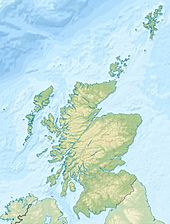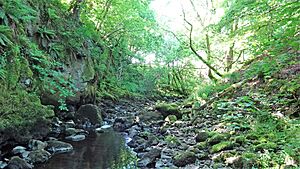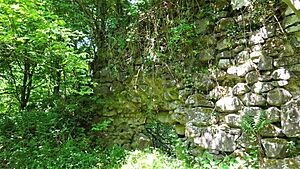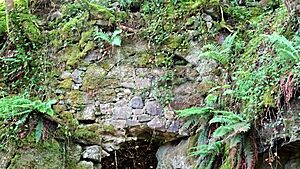Duchal Castle facts for kids
Quick facts for kids Duchal Castle |
|
|---|---|
| Kilmacolm, Inverclyde, Scotland UK |
|
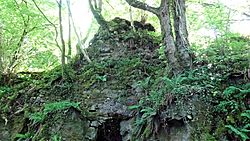
Remnants of the castle's keep from the courtyard
|
|
| Coordinates | 55°52′51″N 4°39′51″W / 55.880943°N 4.6640600°W |
| Type | A courtyard castle and motte |
| Site information | |
| Open to the public |
No |
| Condition | A ruin |
| Site history | |
| Built | 13th century |
| Built by | de Lyle |
| In use | 13th to early 18th century |
| Materials | Stone |
Duchal Castle is an old castle ruin located about 1.5 miles west of Kilmacolm in Scotland. It's found in the Inverclyde area, which is part of the historic county of Renfrewshire. The castle sits in a valley near the River Gryfe. It's on a piece of land surrounded by two streams, the Blacketty and Green Waters, which meet nearby.
Contents
Duchal Castle's Story
Early Days of the Castle
The Lyle family owned Duchal Castle starting in the 12th century. They were also known as L'Isle or Lyell. Ralph de Insula of Duchal lived during the time of King Alexander II (1198–1249). He might have built the very first castle here.
In the mid-1400s, a Lord Lyle was given a special title by King James II. Later, Sir Robert Lyle became a top judge and an advisor to King James III. The Lyle family continued to own the castle for many years.
You can still find a place called 'Moothill' nearby. This name shows where the old local court used to meet. The castle's name, 'Duchal,' was often spelled 'Duchall' on old maps.
Battles and Changes
In 1488, Robert Lyle, the 2nd Lord Lyle, fought against the king. He also supported a rebellion in 1489. Because of this, King James IV attacked Duchal Castle. Local stories say that a very large cannon called Mons Meg was used. Another cannon, nicknamed 'Duchal,' was also used.
The king himself came to the siege. The attack only lasted a few days. After the siege, the Lyle family lost their land for a short time. But Sir Robert Lyle managed to regain the king's trust. He even became a top judge again in 1492.
In 1544, Duchal Castle was sold to John Porterfield. Later, in 1578, the castle was attacked and burned by James Cunningham. This was part of a family fight. The castle was repaired and continued to be used.
By 1701, parts of Duchal Castle were falling apart. Catherine Boyd, whose husband was Alexander Porterfield, decided to build a new home. She thought the old castle was too cold and damp. So, Duchal House was built. By 1782, the castle was mostly a ruin. Stones from the old castle were even used to build a summerhouse by the River Gryfe.
A Royal Visit
King James IV often visited Duchal Castle. He had a son named Alexander Stewart with Marion Boyd, one of his mistresses. Alexander was born at the castle in 1497.
On February 22, 1497, the king visited from Glasgow. He made sure money was left for Marion and their baby son. He gave money "to the nurse that fostered Marion Boyd's child." The king also celebrated his 25th birthday at Duchal Castle in 1498.
What Duchal Castle Looks Like Now
The castle's outer walls follow the edge of the land it sits on. This land has steep drops into the streams on both sides. The inside of the castle was flat and divided into two main areas.
At the western end, a deep ditch and a drawbridge helped protect the entrance. You can still see parts of this ditch. On the north-eastern side, there's a stone-lined well or drain. This might have been a small back gate with steps leading down. You can also see openings in the wall for cannons from the 1500s. The thick walls suggest the castle was built in the 13th century.
On the south-eastern side, there's a rocky area that was once the castle's main tower, called the keep. Not much of it is left today. The main entrance was at the north-western corner. There were also two smaller gates. The name 'Duchal' might mean 'Two Rivers,' referring to the streams nearby.
The Covenanters and Duchal
The Porterfield family, who owned Duchal, supported a group called the Covenanters. These were people who wanted to protect the Scottish church. Because of this, the family faced problems in 1684. The owner, known as 'Melfort's Martyr,' was even put in prison.
Before he was arrested, two spies pretending to be Covenanters came to Duchal. Lady Duchal suspected them because they didn't say grace before eating. She had them watched. When she found out they were spies, she had them held until an officer came for them.
Duchal House
Duchal House was built in 1710, east of the old castle. As was common back then, many stones from the old castle were used to build the new house. Duchal House is still lived in today. Even with new parts added over time, it likely still includes parts of the original 1710 building.


